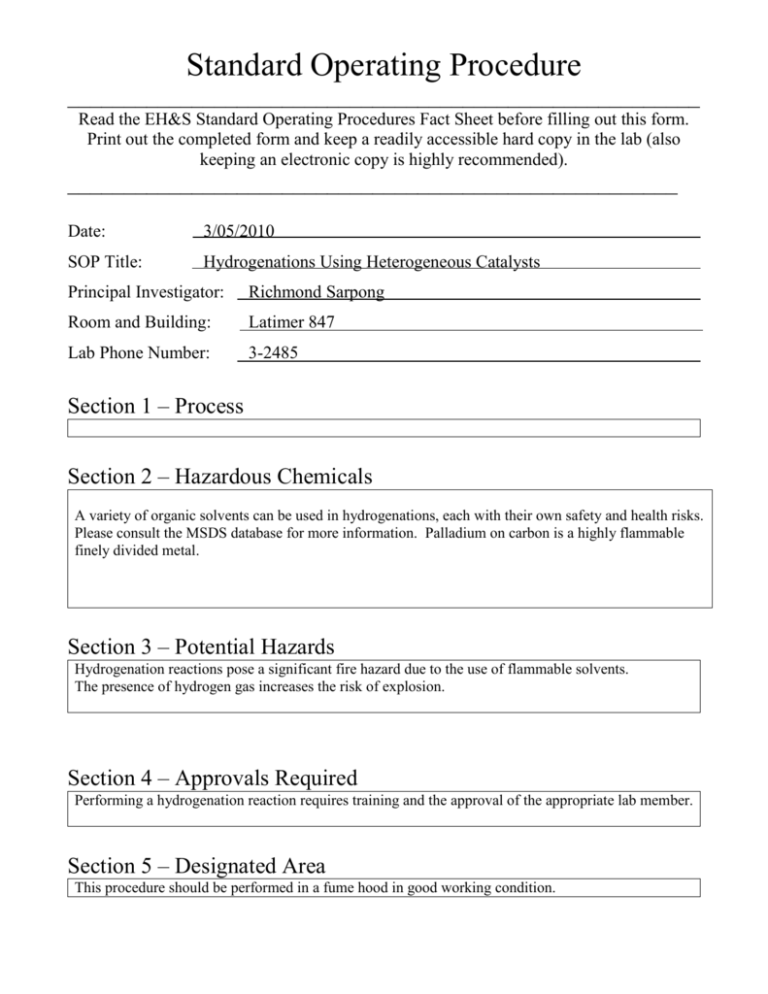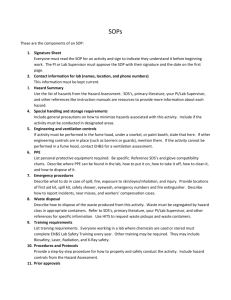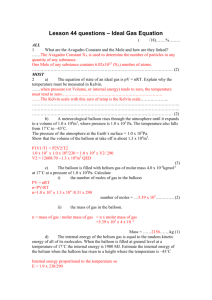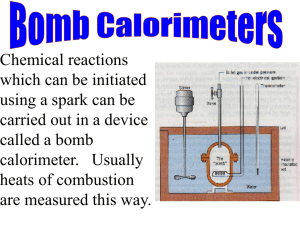Standard Operating Procedures
advertisement

Standard Operating Procedure ________________________________________________________ Read the EH&S Standard Operating Procedures Fact Sheet before filling out this form. Print out the completed form and keep a readily accessible hard copy in the lab (also keeping an electronic copy is highly recommended). ______________________________________________________ Date: 3/05/2010 SOP Title: Hydrogenations Using Heterogeneous Catalysts Principal Investigator: Richmond Sarpong Room and Building: Latimer 847 Lab Phone Number: 3-2485 Section 1 – Process Section 2 – Hazardous Chemicals A variety of organic solvents can be used in hydrogenations, each with their own safety and health risks. Please consult the MSDS database for more information. Palladium on carbon is a highly flammable finely divided metal. Section 3 – Potential Hazards Hydrogenation reactions pose a significant fire hazard due to the use of flammable solvents. The presence of hydrogen gas increases the risk of explosion. Section 4 – Approvals Required Performing a hydrogenation reaction requires training and the approval of the appropriate lab member. Section 5 – Designated Area This procedure should be performed in a fume hood in good working condition. Section 6 – Special Handling Procedures and Storage Requirements Palladium on carbon (Pd/C) frequently ignites when it first comes in contact with methanol (and to a lesser extent, any flammable organic solvent) and as such represents a significant safety risk. These procedures are recommended whenever Pd/C is used in conjunction with hydrogen gas. Hydrogenation using a balloon: 1) Evacuate the reaction vessel (this should have at least two openings) and backfill with an inert gas (nitrogen or argon). 2) Weigh out the desired amount of Pd/C and transfer into the reaction flask under an inert atmosphere. 3) Add a small amount of ethyl acetate, dichloromethane, or toluene to the reaction flask, making sure to wash down any Pd/C stuck to the flask walls. All the Pd/C should be submerged at this point. 4) Carefully add methanol by creating a stream down the side of the flask wall. 5) Add the reaction substrate either as a solution or neat. 6) Begin stirring the reaction mixture and then evacuate the flask just until the solvent begins to bubble, then carefully backfill with inert gas. 7) Repeat step 6 twice more. 8) Attach a balloon of hydrogen to your flask with an adapter that allows the balloon to be closed off from the reaction flask. 9) With the hydrogen balloon closed off, evacuate the flask until the solvent begins to bubble, and then open the balloon to the flask. 10) Repeat step 9 twice more. Hydrogenation using a bomb reactor: 1) purge the bomb with inert gas, then follow steps 2-5 from the procedure above (“hydrogenation using a balloon”). 2) Seal the bomb under an inert atmosphere and then evacuate it using a mild vacuum source. Close the bomb off from the vacuum source and take it to the hydrogen source. 3) Connect the bomb directly to the hydrogen tank regulator using threaded fittings and fill the bomb with hydrogen up to the desired pressure (use the gauge on the bomb to determine the reaction pressure). 4) Close the bomb off from the hydrogen source so that it is now sealed. Close off the hydrogen cylinder using the regulator on the hydrogen tank, and disconnect your bomb from the regulator. Your reaction is now ready to be left to its own devices. When you are ready to work it up, use the following procedure. Workup: 1) For balloon reactions: Detach the hydrogen balloon from the flask and fill with inert atmosphere. For bomb reactions: Connect a vent line to the bomb and then run the vent line to the back of the fume hood. Then slowly and carefully vent the reaction mixture to atmospheric pressure. 2) Filter the reaction mixture through a bed of Celite (or similar filter aid) 3) Taking care not to let the filter cake filter to dryness, wash with the desired solvent (typically the same solvent used in the reaction) 4) Disconnect the filter from the receiving flask, and then add several mL of water to the filter. 5) Discard the slurried Pd/C and filter aid in a dedicated waste jar that contains water. NOTE: If you must add catalyst to solution, prepare a slurry of Pd/C in dichloromethane or toluene (using steps 1-3 above) and then add this slurry to your reaction mixture. However, this should not be seen as a preferred method. Section 7 – Personal Protective Equipment Gloves, laboratory coat, and safety glasses (or goggles) are required to run a hydrogenation reaction. Reactions under pressure should be placed behind a blast shield unless they are in a bomb reactor rated to withstand the desired reaction pressure. Section 8 – Engineering/Ventilation Controls This procedure should be performed in a fume hood in good working condition. Reactions under pressure should be placed behind a blast shield unless they are in a bomb reactor rated to withstand the desired reaction pressure. Section 9 – Spill and Accident Procedures In case of small fires, Metal-X, soda ash, or sand can be used. In case of a large fire, use a CO2 or ABC fire extinguisher. Do not use water if the reaction was run in a non-alcoholic solvent. In case of an explosion, close the sash of the fume hood. An explosion during a hydrogenation usually expels the contents of the reaction vessel, which can lead to a fire. Be prepared to extinguish a fire. If the contents do not immediately ignite, use a large volume of water or sand to quench the catalyst. Section 10 – Waste Disposal Organic solvents can be discarded in the mixed organic waste stream. Palladium waste should be separated from the mixture and placed in a labeled container that contains water. Any filtration aids such as Celite should also be discarded in the palladium waste stream. It is important to make sure any solid waste from a hydrogenation has been exposed to water prior to disposal Section 11 - Decontamination Remove all contaminated clothing, wash all contaminated skin with copious amounts of water. Section 12 – Process Steps Process Steps Safety Measures Training Documentation Name (Printed) Signature Date










